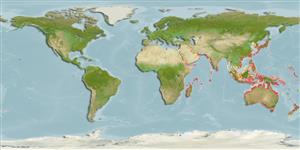Environment: milieu / climate zone / djupintervall / distribution range
Ekologi
marina revassocierade. Tropical
Indo-West Pacific: Arabian Sea to southern Japan.
Length at first maturity / Size / Vikt / Age
Könsmognad: Lm ?, range 34 - ? cm
Max length : 60.0 cm TL hane/ej könsbestämd; (Ref. 9710)
Inhabits coastal reefs, near rocky and coral areas (Ref. 9710). In Hong Kong live fish markets (Ref. 27253).
Oviparous, distinct pairing during breeding (Ref. 205).
Masuda, H. and G.R. Allen, 1993. Meeresfische der Welt - Groß-Indopazifische Region. Tetra Verlag, Herrenteich, Melle. 528 p. (Ref. 9137)
IUCN Red List Status (Ref. 130435: Version 2025-1)
Threat to humans
Harmless
Human uses
Fiskeri: kommersiell; Vattenbruk: kommersiell
Verktyg
Special reports
Download XML
Internet-källor
Estimates based on models
Preferred temperature (Ref.
123201): 16 - 29.2, mean 27.8 °C (based on 3072 cells).
Phylogenetic diversity index (Ref.
82804): PD
50 = 0.5000 [Uniqueness, from 0.5 = low to 2.0 = high].
Bayesian length-weight: a=0.01950 (0.00835 - 0.04555), b=2.95 (2.76 - 3.14), in cm total length, based on LWR estimates for this (Sub)family-body shape (Ref.
93245).
Trofisk nivå (Ref.
69278): 3.5 ±0.49 se; based on food items.
Resiliens (Ref.
120179): Mellan, lägsta populationsfördubblingstid 1,4-4,4 år (Preliminary K or Fecundity.).
Fishing Vulnerability (Ref.
59153): Moderate vulnerability (44 of 100).
🛈
Nutrients (Ref.
124155): Calcium = 26 [12, 52] mg/100g; Iron = 0.488 [0.255, 0.881] mg/100g; Protein = 18.9 [16.9, 20.8] %; Omega3 = 0.096 [0.048, 0.170] g/100g; Selenium = 38.5 [21.5, 69.2] μg/100g; VitaminA = 45.8 [13.7, 147.2] μg/100g; Zinc = 0.905 [0.590, 1.358] mg/100g (wet weight);
